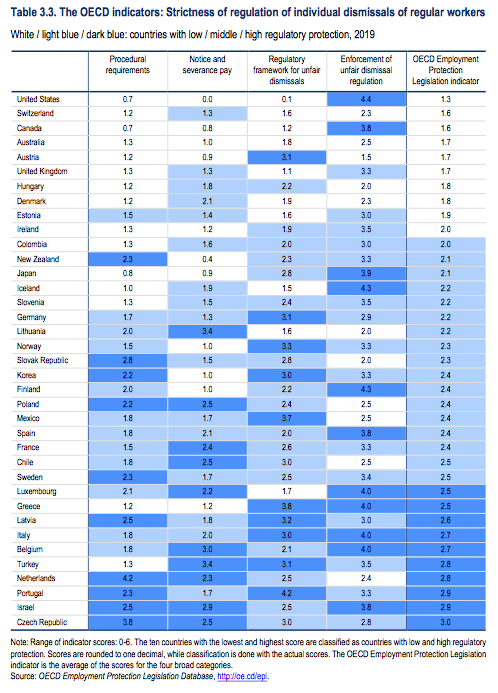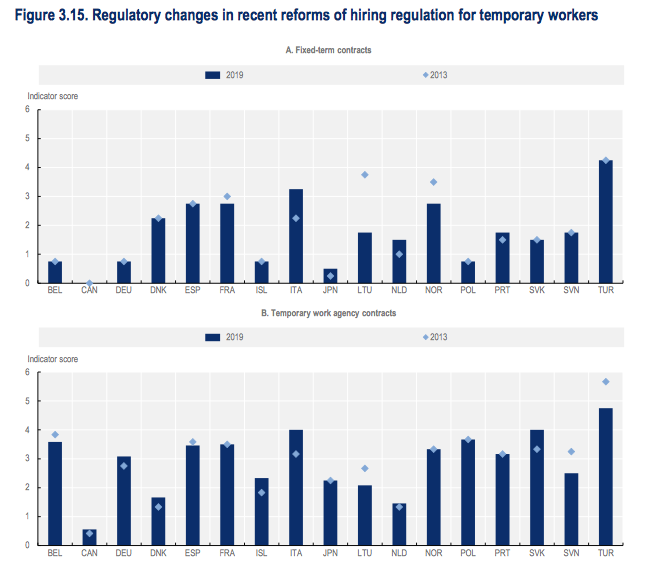Following the general article published in August on the OECD Employment Outlook 2020 on worker security and the Covid-19 crisis, this news focuses on its Chapter 3 on “Recent trends in employment protection legislation”. This chapter describes and compares “the regulation of individual and collective dismissals of workers on regular contracts and the regulation for hiring workers on temporary contracts” between 2013 and 2019.
The OECD developed indicators through the OECD Employment Protection Legislation Database and based on a detailed description per country of employment protection legislation in 2019.
Among the Chapter’s main findings, the following outcomes are worth mentioning:
- “Job dismissal regulations exhibit large differences across OECD countries: English-speaking countries are among those with fewer restrictions on dismissals, so that the layoff risk for workers is higher. Many European Union (EU) countries as well as a few non-EU countries have more restrictions on dismissals and high job security for workers on regular contracts”.
- Countries with strict job protection provisions for regular workers usually have strict hiring conditions for workers on fixed-term or for user’s firms to get an agency worker assigned. “Strict job protection provisions for regular workers require strict hiring laws for temporary workers to limit labour market duality and segmentation (the degree to which firms substitute less flexible regular contracts with more flexible temporary contracts)”.
- “The granular comparisons of employment protection in this chapter highlight which elements of job dismissal regulations play a particularly important role in the different OECD countries. The chapter shows for example where notice periods and severance pay are the highest (in Turkey, Lithuania and Israel for workers who have been in their job for four years), where there are relatively fewer rights relating to unfair dismissals (in the United States, the United Kingdom and Canada) and where advance validations of dismissals and pre-termination resolution mechanisms are strongest (in Austria and the Netherlands)”.
- “Thirty-two of the 37 OECD countries impose more restrictions on collective dismissals than on individual dismissals, mostly because of stricter consultation requirements before notice can be given. These higher restrictions reflect the greater challenge for the economy of dealing with a collective dismissal. Nevertheless, pooling several individual layoffs in one collective dismissal can, in some cases, reduce the administrative burden of the firm.”
The report presents several important reforms in OECD countries and highlights how “in the current Covid-19 health and economic crisis, several EU countries have taken temporary action to considerably strengthen protection against dismissals”.
At the outset of Chapter 3, very useful information is provided on how job protection matters for labour market and economic outcomes. For instance, “dismissal regulation is desirable to avoid excessive worker turnover; overly strict regulation can, however, reduce hiring and layoffs below their optimal level” and “strict dismissal regulation tends to reduce layoffs, which is a direct result of its intended effect to raise the costs of dismissals. It also tends to reduce hiring, as firms factor in the higher costs for a potential dismissal already at the time of hiring. Dismissal regulation therefore reduces both flows out of jobs and flows into jobs. Aggregate employment and unemployment do not appear to be affected much. Fewer job flows mean lower risk of job loss, which to a certain extent is a good outcome as it countervails an otherwise inefficiently high dismissal rate. When job protection is too high, however, efficient job allocation and innovation are likely to suffer. Hence, overly strict dismissal regulation tends to reduce productivity growth and increase the duration of unemployment spells”.
This is extremely important both from an employer and workers’ perspectives, since labour law reforms or negotiating collective agreements require social partners to strike a balance between all interests at stake, depending on whether a country needs to increase its productivity or improve innovation. Questions such as how to modernise the labour market or how to improve active labour market policies, are key for policy makers.
The report also describes the important difference “between workers on regular contracts and workers on temporary contracts. Workers on regular contracts usually benefit from greater employment protection than workers on temporary contracts”.
An important innovation of this Report is the improvements on the methodology, especially the update of indicators on collective dismissals and further additional elements of analysis, including the enforcement of unfair dismissals.
The table below shows how the indicators are used.

Overall, the OECD report finds that, on average “open-ended contracts have loosened, while fixed term contracts have been evenly loosened and restricted across OECD member countries. The EPL ratings on agency work overall increased very slightly by 0.02 points (e.g. overall regulations for firms contracting an employment agency became slightly stricter) between 2013 and 2019. Extensive increases are observed in Italy, Slovakia, Iceland, Denmark and Germany, while decreases occurred in Slovenia, Turkey and Lithuania”.

